When you buy through our links, we may earn an affiliate commission.
When you start to build up a collection of effects pedals, keeping your equipment organized can become a challenge.
Pedalboards offer the perfect solution, allowing you to always have your effects chain ready to use. We’ve identified the best pedalboards, with options to suit every musician’s setup, no matter how many effects pedals you have.
Our favorite pedalboard is the Pedaltrain Classic 2 SC for its durable, portable, and extensive design.
Having an excellent pedalboard will allow you to focus on playing your instrument and using your effects more efficiently. Let’s take a look at the best options out there!
Quick Summary of the Best Pedalboards
- Pedaltrain Classic 2 SC (Best Overall)
- Voodoo Lab Dingbat Power Package (Best Pedalboard with Power Supply)
- Boss BCB-90X Deluxe Pedalboard and Case (Most Portable Pedalboard)
- Pedaltrain Classic Jr SC (Best Compact Pedalboard)
- Temple Audio DUO 24 Templeboard - Gunmetal (Best Budget Pedalboard)
- D'Addario XPND Pedalboard (Most Durable Option)
Best Pedalboards
1. Best Overall – Pedaltrain Classic 2 SC
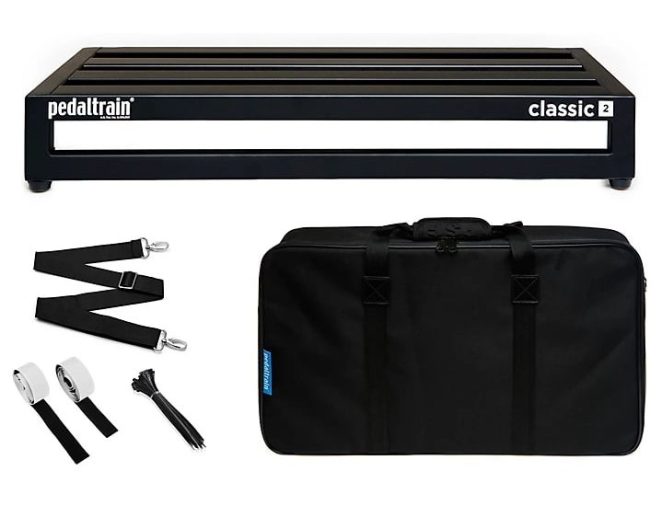
SPECS
- Length: 24"
- Depth: 12.5"
- Powered: No
- Material: Featherweight Aircraft Grade Aluminum
Pedaltrain is one of the leading manufacturers of pedalboards, and the Classic 2 demonstrates why. Building upon the success of the PT-2, this pedalboard features several notable improvements to the classic design.
Firstly, it has been raised by one inch, simplifying the process of power supply mounting. Even the largest power supplies can now be conveniently secured underneath the top surface, helping to keep your power cables organized.
One issue I’ve often found with pedalboards is that they don’t provide enough space for the power cables to be routed through when a power supply is placed underneath, but the four-rail design of the Classic 2 ensures that this isn’t a problem.
If you’re concerned about your pedal’s controls and parameters being altered unintentionally, the addition of a protective soft case will put your mind at ease. You also get all of the adhesive, hook, and loop fasteners you need to secure your pedals immediately.
This popular medium-sized pedalboard benefits from aircraft-grade aluminum construction, which is incredibly lightweight, considering its durability. Overall, I highly recommend it to musicians with around 6-8 regular-sized pedals.
2. Best Pedalboard with Power Supply – Voodoo Lab Dingbat Power Package
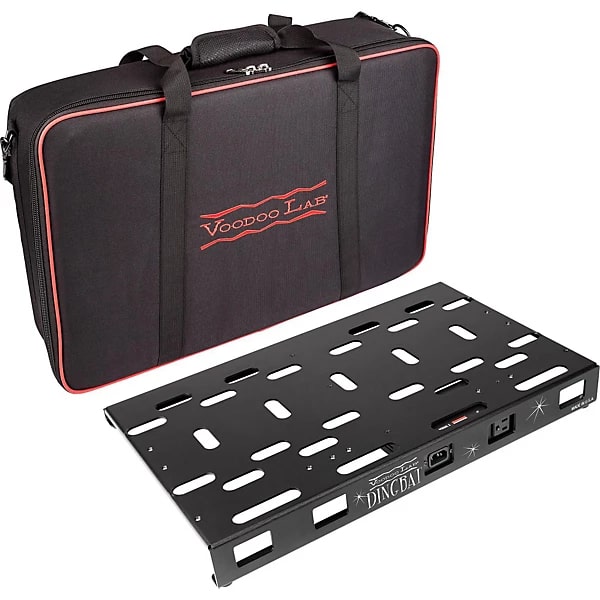
SPECS
- Length: 22"
- Depth: 13.5"
- Powered: Pedal Power 2 Plus
- Material: Lightweight American 6061-T6 Aluminum
The Voodoo Lab Dingbat is a legendary pedalboard that has been part of my guitar setup for several years. The straightforward design and large surface area that can easily fit up to eight pedals make it a great choice for musicians who like to use a wide range of effects.
One of the reasons I like the Voodoo Lab Dingbat so much is that it has the depth required to fit a wah or volume pedal, which are two devices I frequently use when playing guitar.
Another standout thing about this pedal board is that it comes with the excellent Pedal Power 2 Plus power supply included. This device can power eight pedals simultaneously, with 9V, 12V, and 14.5V DC settings.
You won’t need to worry about your pedals being damaged or any settings being changed while in transit, thanks to the robust gig bag that the pedalboard comes in. The bag has comfortable shoulder straps and a handle to make your pedals more portable.
3. Most Portable Pedalboard – Boss BCB-90X Deluxe Pedalboard and Case
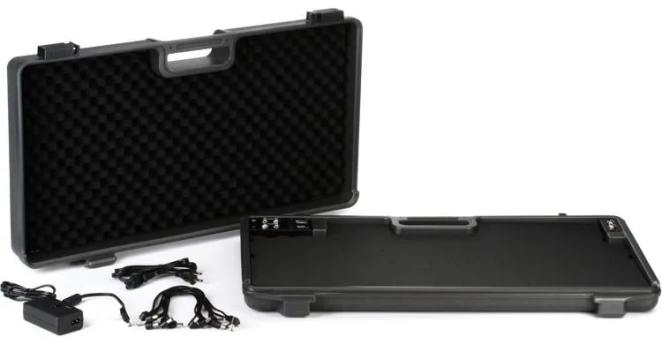
SPECS
- Length: 26"
- Depth: 15.1"
- Powered: PSB-1U adapter
- Material: Moded Plastic and High-Density Foam
Combining a pedalboard with a hard case is a wise move, particularly for musicians who are constantly switching between rehearsal spaces, gig venues, and recording studios.
Boss pedals are known for their legendary build quality, and the BCB-90X Deluxe pedal board also has this in abundance. Other than its durability, our favorite thing about this pedal board is how customizable it is.
Rather than going straight to metal and relying on adhesive strips or hook and loop fastening, you use a utility knife to cut the dense foam to the exact shape and size of your pedals. This ensures that they stay firmly in place when the case is shut.
Along with its mobility and protective qualities, we’ve selected this as one of the best pedalboards because it can hold a large selection of devices. The PSB-1U integrated power supply mounting is the final piece of the puzzle, allowing you to power up to ten pedals at once.
The only thing that could perhaps be improved about the design is that it is not angled, but this doesn’t affect its functionality.
4. Best Compact Pedalboard – Pedaltrain Classic Jr SC

SPECS
- Length: 18"
- Depth: 12.5"
- Powered: No
- Material: Featherweight Aircraft Grade Aluminum
The Classic JR boasts all of the outstanding qualities of our top pick, the Classic 2 SC, but in a more compact and portable format. Pedaltrain’s design makes it easy to position your stompboxes, maximizing space and avoiding overcrowding this aluminum pedalboard.
This guitar pedalboard may be smaller than some of our other recommendations, but it’s perfect if you only use a few pedals and want to keep your rig as mobile as possible. The included hook and loop velcro makes it easy to secure your existing pedals in place, so they won’t budge when used.
One of the things that stood out to me about this small pedalboard is how it balances a lightweight design with impressive durability. It also provides enough space to mount power supplies with ease.
Although the compact size of this pedalboard means it’s not a great choice for musicians with a large pedal collection, I’ve found it to be very useful for stripped-back performances or rehearsals when you only need to use the essential effects.
5. Best Budget Pedalboard – Temple Audio DUO 24 Templeboard - Gunmetal
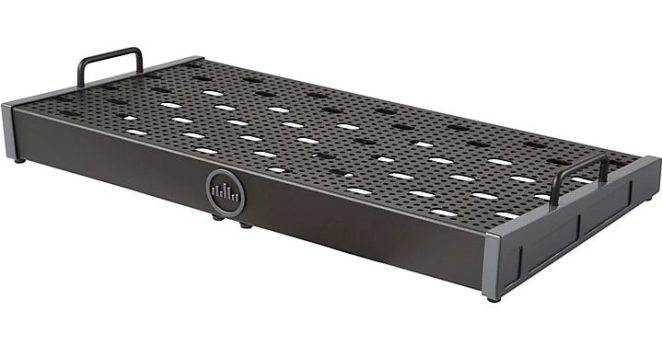
SPECS
- Length: 24.5"
- Depth: 12.5"
- Powered: No
- Material: Lightweight Aluminum
Temple Audio’s DUO 24 Templeboard is an innovative pedalboard that is highly versatile. If you use a lot of pedals as I do, or you need space for larger devices like volume pedals or multi-fx units, the 24” length of this pedalboard will be very useful.
Not only can you fit up to twelve standard-sized stompboxes across the three rows of this pedalboard, but you can also move them around quickly and easily, thanks to the way they are secured.
Rather than relying on adhesive and velcro to mount the pedals, you attach them using mounting plates with a thumb-screw locking mechanism. These are sold separately from the pedalboard, but they will save you the cost of having to buy hook and loop velcro in the future.
I was particularly impressed by the aesthetics of this pedalboard. It’s sleek and understated and will look great onstage. Also, the two heavy-duty handles installed on either side make it easy to move into place or store away when not in use.
6. Most Durable Option – D'Addario XPND Pedalboard
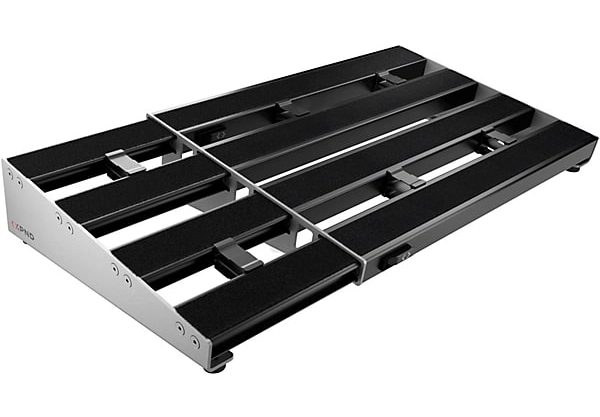
SPECS
- Length: 17.25"-31.75" (Adjustable)
- Depth: 12.8"
- Powered: No
- Material: Lightweight Aluminum
The D’Addario XPND is a smartly designed guitar pedalboard that offers unrivaled convenience. The adjustable size is very useful when you need to store the pedalboard away when it’s not in use.
I found the best way to use this pedalboard is to secure your staple effects, such as your drive pedals and any modulation effects you frequently use, to the center of the board. Then, when you extend the pedalboard out, you can add your dynamic effects on either side.
The double-row design of the XPND makes it compatible with larger pedals, so you won’t need to worry about finding space for your wah-wah or whammy pedal.
Another thing that stood out to me about this pedalboard was how secure it feels, which is largely thanks to the rubber feet that grip the floor and prevent movement.
Best Pedalboards Buyer's Guide
The best pedalboards must be compatible with your existing guitar, bass, or other instrument setup. It’s important to consider all the necessary factors before deciding which option to go for.
Perhaps you need a pedal with an onboard power supply, or you’d like to mount your current power supply underneath. A compact, lightweight pedalboard may suit smaller pedal setups, but if you use a wide range of effects, you’ll need plenty of pedal space to work with.
In this buyer’s guide, you’ll find all the information you need to know to find the ideal pedal board for your requirements.
We’ll cover everything from the physical aspects of pedalboards to all the necessary accessories you need to be aware of and provide tips on important aspects like cable management and securing pedals.
Things to Look for When Buying a Pedalboard
1. Size and Capacity: The first thing that you need to determine is the size of the pedalboard. The board must be large enough to fit all of your effects pedals on it and to accommodate any future additions you intend to make.
It’s also important to consider mobility, as larger pedalboards are more difficult to transport and store.
2. Material and Durability: Pedalboard manufacturers use various materials when constructing these devices. One of the most popular materials is aluminum, which provides ample durability without being too heavy.
Strong plastics and foam may also be used on some pedalboards, particularly if they are part of a case.
3. Power Supply: Pedalboards that come with a built-in power supply are convenient, as they allow you to connect all of your pedals and use them instantly.
If you already have a power supply, look for a pedalboard with enough space for it to be mounted underneath or on the top along with your stompboxes.
4. Portability and Ease of Setup: If you’re a touring musician or you often use your equipment in different locations, it’s imperative that you consider both the portability of your pedalboard and how easy it is to set up.
Ideally, you want to leave all of your pedals on the board plugged into the power supply so that they can be used without any hassle.
Pedalboard Size and Layout
Before deciding between the best pedalboards we’ve recommended, it’s very important to think about what you’re looking for from your board.
A guitarist who has two or three small stompboxes and is just learning to play the instrument is going to need a different type of pedalboard than a musician who has an array of effects and is playing multiple shows a week.
The size of your pedalboard will determine how many effects pedals you can use in your signal chain, so I recommend checking that the measurements of your pedals are compatible with the board's dimensions.
It’s also important to bear in mind that there will need to be an inch or two space between each pedal so that the patch cables can be connected. If you’re using wah or volume pedals, you’ll need more room to ensure that the rocker plate mechanism can be used.
Pedalboards with large surface areas, like the Voodoo Lab Dingbat, are ideal for musicians who need plenty of room. However, if you’d prefer to keep your setup as compact and portable as possible, something like the Pedaltrain Classic Jr SC is a better option.
I would also recommend thinking about whether you plan on adding other pedals to your effects signal chain in the future and factoring this into your decision. It’s worth getting a board with more space than you currently need to prevent having to upgrade soon when you expand your collection.
Materials and Build Quality
One of the challenges pedalboard manufacturers face is ensuring they’re durable enough to withstand the inevitable rigors of performing, rehearsing, and recording while making them as portable as possible.
To achieve this, they must use specific materials that aren’t too heavy but solid and robust enough to last for many years.
One of the most common materials is lightweight aluminum, which boasts exceptional longevity but isn’t as heavy as most other metals. Some options, like the Classic 2 SC, are made from featherweight aircraft-grade aluminum, which is arguably the perfect material for a pedalboard.
If your goal is to keep your setup as easy to transport as possible, opting for a pedalboard that is made from plastic may be a better choice. However, it's important to remember that plastic pedalboards are more likely to break than metal ones.
Power Supply
The power supply is an integral part of your effects pedal setup; therefore, you need to consider it when choosing a pedalboard. If you already own a power supply, you won’t need to look for a pedal board with an integrated one for powering your pedals.
Although the placement of a power supply may not seem as interesting as where you position your pedals, it’s just as important. The power supply provides the necessary electrical current to your pedals via power cables and, therefore, must be placed in an optimal way to reach each device.
Many pedalboards, such as the Voodoo Labs Dingbat, have space for the power supply to be mounted underneath. This is convenient because it maximizes the space you have available on the top of the pedalboard.
Another advantage of using a pedalboard that allows you to mount the pedalboard on the underside is feeding the power cables through the gaps in the railings, keeping them organized and tidily tucked away.
The Dingbat and the Boss BCB-90X each come with a power supply. If you don’t already own one, choosing one of these options will save you the hassle of finding one that fits the board's dimensions sufficiently.
While an integrated power supply is more efficient and easy to set up, it does lack the flexibility of using a pedalboard with a separate power supply. If your power supply malfunctions, you can easily replace it with a new device or upgrade it as you amass more pedals.
Soft Cases vs. Hard Cases
Several of the pedalboards we’ve recommended come with a case. This makes them easier to carry and provides protection for your pedals, preventing the settings from being altered.
Soft cases are generally more affordable and lightweight, but they don't provide the same protection level as harder cases. If you have a lot of expensive pedals that you want to shield from any wear and tear, a pedalboard with a hard case like the Boss BCB-90X is definitely the way to go.
Many hard-cased pedalboards have foam interior layers, which provide further cushioning for the pedals and prevent them from being damaged even if the case is dropped or moved while being transported.
Frequently Asked Questions (FAQs)
How can you figure out what size pedalboard you need?
The size of the pedalboard you require ultimately depends on two things - the quantity and size of your guitar pedals. It's useful to measure the dimensions of each pedal you intend to mount on the board so that you can determine the best pedalboards for your existing effects chain.
Guitar pedal boards come in various sizes. Some are designed to accommodate up to ten effects or more, while others are for minimalistic setups, which only include your prized pedals. If you only use a tuner, an overdrive pedal, and a reverb pedal, you probably don't need a pedalboard that is 24 inches long.
However, it's important to keep in mind that you may want to add to your pedal collection in the future, or upgrade your pedal power supply, which may mean you need more space.
While it's impossible to predict the future, if there are multiple pedals you intend to purchase at some point, factor this into your decision when choosing the pedalboard size.
What is the best way to secure pedals to the pedalboard?
You can secure pedals to your pedalboard in several ways, but they are likely to vary depending on the design. The most common method is hook and loop fasteners, essentially adhesive back velcro strips.
These are cheap and easy to use, but they will likely need to be replaced regularly if you want to move the pedals around.
Some pedalboards come with pedal fastener mechanisms, such as plates, which provide more flexibility and stability but will increase the pedalboard cost, as they are commonly sold separately.
How should you organize pedals for the best sound and accessibility on the pedalboard?
There are many different opinions when it comes to the best way to arrange your pedals on a pedalboard, but ultimately you need to consider two things.
Firstly, you should stick to the order that gets you the desired sound from your pedals, and secondly, you need to ensure that the pedals are spaced out logically.
The most widely accepted order for effects pedals is, to begin with your tuner, then any dynamic pedals, followed by gain-based pedals, modulation pedals, and finally, reverb and delay pedals.
Remember that your patch cables must also reach the next pedal in the chain, so it's important to consider this when organizing your pedals.
Closing Thoughts
After reading this guide on the best pedalboards, you can now decide which of our recommendations suits your needs.
Our #1 pick is the Pedaltrain Classic 2 SC, which is great value for the price. If you need a larger pedalboard with an included power supply, the Dingbat by Voodoo Lab is definitely worth considering.
Adding one of the best pedalboards we’ve suggested to your setup will make your equipment more organized, easier to use, and better protected! We hope you enjoy these benefits and more from your new pedalboard.
